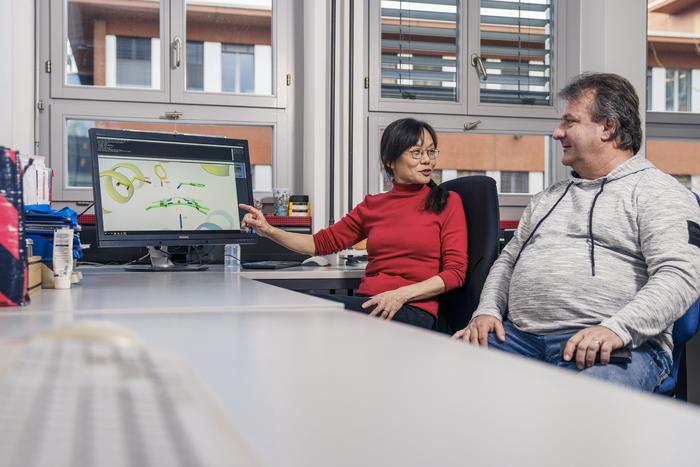Researchers at the Paul Scherrer Institute PSI have for the first time precisely characterised the enzyme styrene oxide isomerase, which can be used to produce valuable chemicals and drug precursors in an environmentally friendly manner. The study appears today in the journal Nature Chemistry.

Credit: Paul Scherrer Institute/Markus Fischer
Researchers at the Paul Scherrer Institute PSI have for the first time precisely characterised the enzyme styrene oxide isomerase, which can be used to produce valuable chemicals and drug precursors in an environmentally friendly manner. The study appears today in the journal Nature Chemistry.
Enzymes are powerful biomolecules that can be used to produce many substances at ambient conditions. They enable “green” chemistry, which reduces environmental pollution resulting from processes used in synthetic chemistry. One such tool from nature has now been characterised in detail by PSI researchers: the enzyme styrene oxide isomerase. It is the biological version of the Meinwald reaction, an important chemical reaction in organic chemistry.
“The enzyme, discovered decades ago, is made by bacteria,” says Richard Kammerer of PSI’s Biomolecular Research Laboratory. His colleague Xiaodan Li adds: “But because the way it functions was not known, its practical application has been limited up to now.” The two researchers and their team have elucidated the structure of the enzyme as well as the way it works.
Simple mechanism for a complicated reaction
Microorganisms possess specific enzymes with which they can, for example, break down harmful substances and use them as nutrients. Styrene oxide isomerase is one of these. Together with two other enzymes, it enables certain environmental bacteria to grow on the hydrocarbon styrene.
The styrene oxide isomerase catalyses a very specific step in the reaction: it splits a three-membered ring in the styrene oxide consisting of one oxygen and two carbon atoms, a so-called epoxide. Thereby the enzyme is highly specific and creates only one product. It is also capable of converting a number of additional substances, producing important precursors for medical applications.
One particular advantage has to do with the fact that in many chemical reactions, both an image and a mirror image of a chemical compound are formed, which may have completely different biological effects. But this enzyme specifically creates only one of the two products. In chemistry this property is called stereospecificity – it is particularly important for the generation of precursor molecules for drugs. “The enzyme is an impressive example of how nature makes chemical reactions possible in a simple and ingenious way,” Xiaodan Li says.
Versatile
In the course of their investigations, which they conducted in part at the Swiss Light Source SLS, the PSI researchers discovered the enzyme’s secret: an iron-containing group in its interior, similar to the iron-containing pigment in our red blood cells. This haem group binds the epoxide ring, and that’s how it makes the reaction so simple and efficient. Other parts of the investigations were carried out by the group of Volodymyr Korkhov, also from the PSI Laboratory for Biomolecular Research and Associate Professor in the Department of Biology at ETH Zurich, using cryo-electron microscopy.
Xiaodan Li and Richard Kammerer feel certain that the enzyme will prove extremely useful in the chemical and pharmaceutical industries. “It is so far the only bacterial enzyme known to catalyse the Meinwald reaction,” Richard Kammerer emphasises. With the enzyme’s help, industry could produce precursors for drugs and important chemicals under energy-saving and environmentally friendly conditions.
Xiaodan Li adds: “The enzyme could potentially be altered so that it can produce a great many new substances.” In addition, the enzyme is very stable and thus is suitable for large-scale industrial applications. “It will certainly become a new, important tool for the circular economy and green chemistry,” the PSI researchers are convinced.
Text: Brigitte Osterath
About PSI
The Paul Scherrer Institute PSI develops, builds and operates large, complex research facilities and makes them available to the national and international research community. The institute’s own key research priorities are in the fields of matter and materials, energy and environment and human health. PSI is committed to the training of future generations. Therefore about one quarter of our staff are post-docs, post-graduates or apprentices. Altogether PSI employs 2200 people, thus being the largest research institute in Switzerland. The annual budget amounts to approximately CHF 420 million. PSI is part of the ETH Domain, with the other members being the two Swiss Federal Institutes of Technology, ETH Zurich and EPFL Lausanne, as well as Eawag (Swiss Federal Institute of Aquatic Science and Technology), Empa (Swiss Federal Laboratories for Materials Science and Technology) and WSL (Swiss Federal Institute for Forest, Snow and Landscape Research). Insight into the exciting research of the PSI with changing focal points is provided 3 times a year in the publication 5232 – The Magazine of the Paul Scherrer Institute.
Contact
Dr. Xiaodan Li
Biomolecular Research Laboratory
Paul Scherrer Institute, Forschungsstrasse 111, 5232 Villigen PSI, Switzerland
Telephone: +41 56 310 44 69, e-mail: [email protected] [German, English]
PD Dr. Richard Alfred Kammerer
Biomolecular Research Laboratory
Paul Scherrer Institute, Forschungsstrasse 111, 5232 Villigen PSI, Switzerland
Telephone: +41 56 310 47 65, e-mail: [email protected] [German, English]
Prof. Dr. Volodymyr Korkhov
Laboratory for Biomolecular Research
Paul Scherrer Institute, Forschungsstrasse 111, 5232 Villigen PSI, Switzerland
Telephone: +41 56 310 28 42, e-mail: [email protected] [English]
Original publication
Structural basis of the Meinwald rearrangement catalyzed by styrene oxide isomerase
Basavraj Khanppnavar, Joel P.S. Choo, Peter-Leon Hagedoorn, Grigory Smolentsev, Saša Štefanić, Selvapravin Kumaran, Dirk Tischler, Fritz Winkler, Volodymyr M. Korkhov, Zhi Li, Richard A. Kammerer, Xiaodan Li
Nature Chemistry, 14.05.2024 (online)
DOI: 10.1038/s41557-024-01523-y
Journal
Nature Chemistry
DOI
10.1038/s41557-024-01523-y
Method of Research
Experimental study
Article Title
Structural basis of the Meinwald rearrangement catalyzed by styrene oxide isomerase
Article Publication Date
14-May-2024




